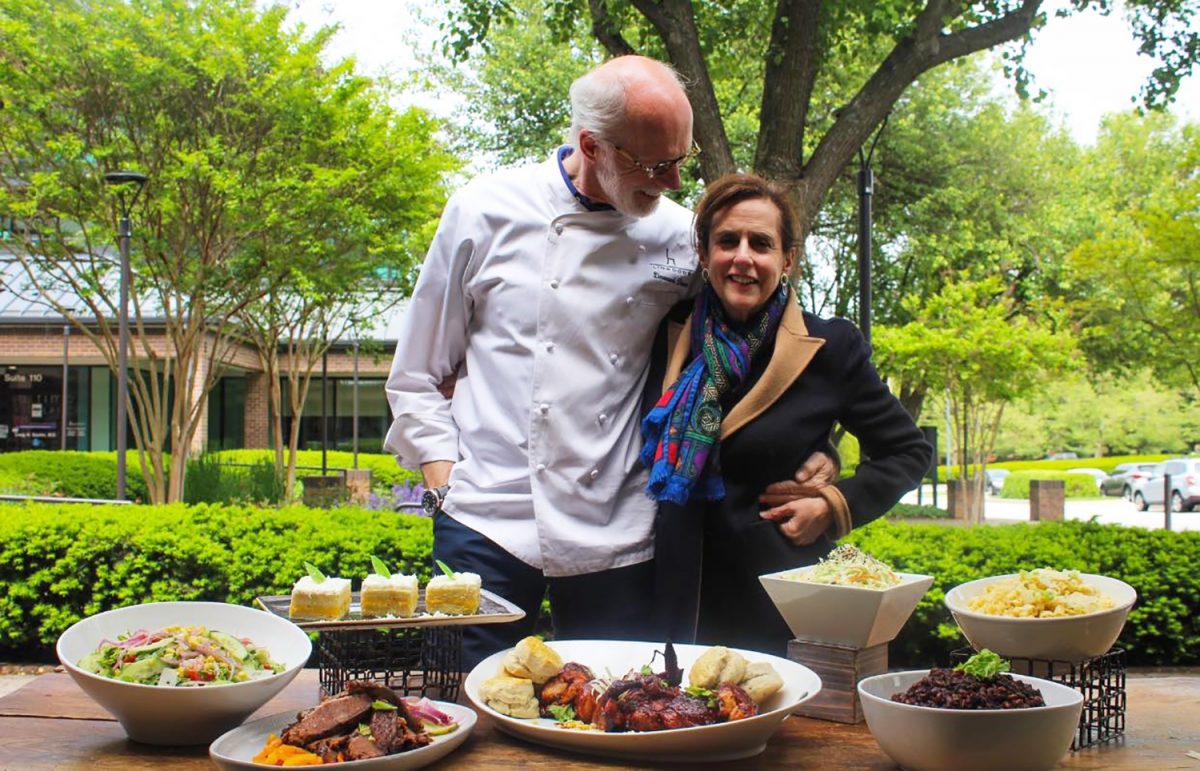
As they drop carryout into cars, Linwood and Ellen Dame can be seen waving from the curb of their Owings Mills fine-dining restaurant. But behind the scenes, they have been busy making preparations to reopen Linwoods once Governor Hogan gives the green light on indoor dining. From turning their popular grill line into a carryout area to using a new health screening app, there are endless details to work through as they get ready to welcome patrons back to their dining room. “We feel like we are starting a new business,” says Linwood. “Everything we did on March 16th doesn’t mean anything anymore, everything is new.”
You waited a little while to open up for curbside carryout. What factored into your decision?
Linwood Dame: When we closed on March 16th, things were in disarray as to what was going on and I really wanted to get more information—for my employees, for my own family—about what we should do and how we should do it. By doing that, we’d do our part by closing up and everyone would just go home. We met the last payroll we had and then furloughed a good amount of people and kept some people on payroll, then waited to see what was going on.
So how is carryout going given that you’re a fine-dining restaurant?
LD: Curbside has been pretty good. We’ve had a great turnout. We were doing it five nights a week and are going to seven nights a week. Overall, the turnout has been pretty good. We are just dropping food in people’s trunks and we are also out there greeting cars—I’ve seen some nice cars go by, by the way. And the conversations I’ve had have been pretty fascinating. People can’t wait to talk to someone—everyone wants to engage in conversation, which is great.
“You really need to think about how you’re going to pack the food. We tested everything. We would make it, put it in the package, and let it sit for a half hour to an hour and figure out what worked and what didn’t work.” —Linwood Dame
I’ve had your carryout myself. In addition to the food being delicious, I noticed how well everything was packaged.
LD: You really need to think about how you’re going to pack the food. We tested everything. We would make it, put it in the package, and let it sit for a half hour to an hour and figure out what worked and what didn’t work, so it took some work to get there. We have things on our menu like octopus and fried Brussels sprouts that people love. We are going to start working on it and see if we can offer those items as carryout.
What hasn’t lent itself to carryout?
Ellen Dame: We decided not to do French fries. We’ve gotten a lot of calls for them, but they just turn into mush.
LD: The fried chicken has worked out well. I’m like a Kentucky Fried Chicken. I love fried chicken, but my god it’s a lot of fried chicken.
I’ve also noticed that you’ve included some nice touches like a bow on the bag and a note from the two of you.
LD: We do appreciate our customers. We want them to know we care, and we want to give them some information about what we are doing in our space—they’ll get more as time goes on. Our customers need to reach a comfort level with us and a trust level to be comfortable—I think that’s really key.
ED: We take pride in our food. We thought the packaging should be reflective of the fact that you’re not just going to the neighborhood pizza parlor and picking up a bowl of spaghetti. We wanted it to feel a little bit more special.
LD: We’ve had people pull up and have tailgate parties in the parking lot.
ED: There was one time where one couple lives in Carroll County and the other couple lives in Harford County and they meet at the restaurant for dinner because it’s halfway for each of them. They met on a Friday night and brought their fold-up chairs and table, they social distanced and they sat in the parking lot.
LD: We had someone in a Mercedes motor home who pulled up to the parking lot, set up a little tent, put the table and the candles out, and ordered wine and dinner.
“People want to see other people. Ninety-nine percent of the people keep their window open to have a conversation and that gives me hope that there is a future for the dining out business. There have been times when I felt really hopeless.” —Ellen Dame
So how is revenue?
LD: Business is down 70 percent—that includes catering.
What do you see as the immediate future of restaurants?
LD: Twenty-five percent to 50 percent capacity isn’t going to work. Some places, if they do a lot of carryout and have low overhead maybe, but that will work for very few restaurants. Places like ours, or Tagliata or Charleston, can’t operate at 50 percent. If you do, you’re going to operate at a loss no matter what happens. The restaurant business is built on volume. You have to have people in seats in order to make it work. For us, I have a lot of space—two big dining rooms where I can fit a fair amount of people at 50 percent and I can spread people out with another 40 seats outside. But what about the restaurant downtown that can only seat 20 people?
ED: We’ve spent a lot of time reimagining what the restaurant business is going to be and how this is going to effect it, both short term and long term. It’s difficult because people are nervous, and I don’t blame them.
LD: We have done a tremendous amount of work within the space. I had countertops replaced and the hood systems completely redone. We’ve power washed the entire restaurant, sanitized everything, and then we are putting UVC lights in the HVAC that kills viruses. They are the same ones they use in hospitals. We’ve already done all our seating spread out six feet apart, we put plexiglass over our hostess stand, and we have sanitizer stations everywhere. Now, we have to get into the protocol of how we take an order, how do we read the menu, what does the server do when they take the credit card…There’s also an app we are going to use called Modjoul—it’s a health screening solution. All of our employees will have this app on their phones and every day. It’s a health check—instead of them coming to the restaurant, it’s done even before they arrive.
ED: It’s what we are doing by hand now—it’s pretty much what the healthcare facilities are doing.
Do you think we will continue to take these kinds of measure once there is a vaccine?
ED: The world is in for a readjustment. Our customers are concerned about their health—these things are going to matter. Woody and I have been standing on the curb every night with a mask and gloves six feet away from the car windows saying, ‘Hi’ to people. And all that first week, it felt really good because people cared, people were happy to see us and to see that we were open. We were also sensing a desire from people just craving contact. People want to see other people. Ninety-nine percent of the people keep their window open to have a conversation and that gives me hope that there is a future for the dining out business. There have been times when I felt really hopeless. In some form the business will come back and go forward. Things will change and a lot of trends out there now won’t survive this. The restaurants that survive are going to have to have a different format.
“Places like ours, or Tagliata or Charleston, can’t operate at 50 percent. If you do, you’re going to operate at a loss no matter what happens. The restaurant business is built on volume. You have to have people in seats in order to make it work.” —Linwood Dame
What will the dining room look like when you reopen?
LD: In the beginning, we are going to put an envelope on the tables, and you can put your mask in there while you’re having dinner. There won’t be salt and pepper on the table and you won’t get lemons and limes. You’ll get a straw that’s still covered in paper. Those are the details that we are still working on. There are thousands of these little details that we have to practice. We will learn as we go along and find things that we haven’t thought of and we will get better and better at it.
Have you been surprised by how fragile the industry is?
ED: For someone like Danny Meyer, who has been incredibly successful and smart in this business, to come out in the first two weeks and say, ‘I give up, there’s no way I can make it except for my takeout burger business,’ is pretty shocking.
LD: But what he said makes a lot of sense. He said, ‘Without a vaccine, the restaurant business is not going to make it on 50 percent seating’—everyone is saying that across the country. Restaurateurs are notorious for saying everything is great when everything is a mess—‘Oh, we had the busiest night of our lives’—yeah, that was three years ago. Now, there’s been a refreshing modesty.
